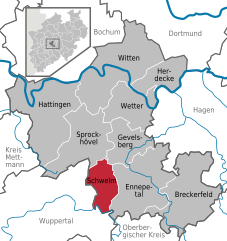Schwelm
show This article may be expanded with text translated from the corresponding article in German. (July 2012) Click [show] for important translation instructions. |
This article needs additional citations for verification. (July 2012) |
Schwelm | |
|---|---|
 | |
 Coat of arms | |
show Location of Schwelm within Ennepe-Ruhr-Kreis district | |
 Schwelm | |
| Coordinates: 51°16′N 7°16′E / 51.267°N 7.267°ECoordinates: 51°16′N 7°16′E / 51.267°N 7.267°E | |
| Country | Germany |
| State | North Rhine-Westphalia |
| Admin. region | Arnsberg |
| District | Ennepe-Ruhr-Kreis |
| Government | |
| • Mayor (2020–25) | Stephan Langhard[1] (SPD) |
| Area | |
| • Total | 20.5 km2 (7.9 sq mi) |
| Elevation | 213 m (699 ft) |
| Population (2020-12-31)[2] | |
| • Total | 28,590 |
| • Density | 1,400/km2 (3,600/sq mi) |
| Time zone | UTC+01:00 (CET) |
| • Summer (DST) | UTC+02:00 (CEST) |
| Postal codes | 58332 |
| Dialling codes | 02336 |
| Vehicle registration | EN |
| Website | www.schwelm.de |

Schwelm is a town in the district of Ennepe-Ruhr-Kreis in the administrative region of Arnsberg within the state of North Rhine-Westphalia.
Geography[]
Schwelm is situated in the southeast of the "Ruhrgebiet", the Ruhr district of Germany, between Westphalia and the "Bergisches Land". Schwelm is commonly known as the "Pforte Westfalens" ("Gate to Westphalia").
Neighbouring places[]
Surrounding towns include Ennepetal, Gevelsberg, Sprockhövel and Wuppertal.
Division of the town[]
Schwelm is called the "town of neighbourhoods". It is made up of the following 13 neighbourhoods:[3]
- Aechte de Muer
- Brunnen
- Fronhof
- Linderhausen
- Loh
- Möllenkotten
- Oberstadt
- Oehde
- Ossenkamp
- Parliament
- Rote Wasser
- Winterberg
- Zur alten Post
History[]
The history of Schwelm can be traced back to the ninth century, where it is first mentioned as "Suelmiu". The town of Schwelm was officially established in 1496 and became seat of the Ennepe-Ruhr district in 1929. According to its area, Schwelm is the smallest town in North Rhine-Westphalia.
Language/dialect[]
A Westphalian variety of high German is spoken in Schwelm (Westphalian: from old Saxon Westfal = "western land"). The Westphalian dialect belongs to the low Saxon dialects, which is a part of the family of low German dialects. Compared to other German regions (e.g., Bavaria or Swabia) the dialect does not have a strong influence on the everyday speech. Especially the elderly population is still able to speak Schwelm's original Westphalian tongue, called Schwelmer Platt, which is quite different from standard high German and bears a certain resemblance to Dutch.
Points of interest[]
Schwelm has got a historical town center with many old houses, some of which date back to the 18th century. The Altmarkt is a historical market place lying in front of the tall Christuskirche, the town's principal Protestant church. From the Altmarkt, the decorative street Kölner Strasse leads uphill and is part of the former road to Cologne.
Until 2011, Schwelm was home to the Brauerei Schwelm, the "Schwelm Brewery", one of few remaining private breweries in North Rhine-Westphalia. Established in 1830 by Haarmann & Kathagen, the brewery was one of the first worldwide to switch from wooden to metal storage containers. The original administration building, the Rietz'sche Haus built in 1701, is an appealing house in the town center. Most of the brewery's historic production site, however, was torn down in 2012.
The oldest piano manufacturer in the world is located in Schwelm. Since 1794, Rud. Ibach Sohn has been building pianos and, until 1904, organs in Schwelm.
Europe's biggest fair-trade organisation "GEPA" was founded in Schwelm in the 1970s, but is now located in Wuppertal.
A historical Jewish cemetery, dating from the late 18th century is located in the countryside about 1.3 km south of the town's center. It is maintained by the municipality and volunteers.[4]
Twin towns – sister cities[]
 Saint-Germain-en-Laye, France (formerly Fourqueux)
Saint-Germain-en-Laye, France (formerly Fourqueux)
Notable people[]

- Friedrich Christoph Müller (1751–1808), theologian and cartographer, lived here in 1785–1808
- Friedrich Springorum (1858–1938), engineer and entrepreneur
- Wilhelm Göcke (1898–1944), Nazi SS concentration camp commandant
- Gustav Heinemann (1899–1976), third president of the Federal Republic of Germany from 1969 to 1974
- Johannes Joachim Degenhardt (1926–2002), Cardinal and archbishop of Paderborn
- Franz Josef Degenhardt (1931–2011), political singer-songwriter
- Martin Grötschel (born 1948), mathematician
- Rolf Rüssmann (1950–2009), football player and manager
- Torsten Schmidt (born 1972), racing cyclist
- Olivia Spiker (born 1981), Polish-German amateur boxer
Gallery[]

View of the Lindeberg-high ridges of the inner town

Schwelmequelle

Grade II listed building No. 12

The boating lake excursion restaurant/mill c.1900

View from the Old Market of the Church

Formerly-moated house Martfeld

Old high-school in the Märkischer

Schwelm train station

Factory building of piano manufacturer Rud. Ibach
See also[]
- Cities in North Rhine-Westphalia
References[]
- ^ Wahlergebnisse in NRW Kommunalwahlen 2020, Land Nordrhein-Westfalen, accessed 19 June 2021.
- ^ "Bevölkerung der Gemeinden Nordrhein-Westfalens am 31. Dezember 2020" (in German). Landesbetrieb Information und Technik NRW. Retrieved 21 June 2021.
- ^ "Schwelm - town of neighbourhoods". Retrieved 20 October 2013.
- ^ Helbeck, Gerd: Juden in Schwelm. 1st ed. 1988, 2nd ed. 2007 (written by a renowned town archivist and printed by the local Historical Society, the book includes a chapter on the cemetery)
- ^ "Partnerstadt". schwelm.de (in German). Schwelm. Retrieved 2021-03-09.
External links[]
| Wikimedia Commons has media related to Schwelm. |
| Wikisource has the text of the 1911 Encyclopædia Britannica article Schwelm. |
- Official website
 (in German)
(in German) - History of Schwelm (in German)
- Towns in North Rhine-Westphalia
- Ennepe-Ruhr-Kreis
- Province of Westphalia











